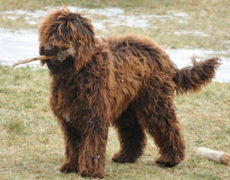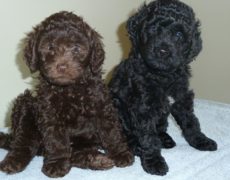Barbet Dog
The Barbet is an old dog breed that originated in France. They have a typical water dog appearance with webbed feet, and their entire body covered with water-resistant, wooly coat. They are medium size dogs that are often confused with poodles with their broad head, hanging ears, small button-like nose eyes and tip, a well-shaped body and a long, hanging tail. The Barbet is neither common nor a popular breed.
Barbet Dog Pictures
- Barbet Dog Brown
- Barbet Dog Images
- Barbet Dog Pictures
- Barbet Dog Puppy
- Barbet Dog White
- Barbet Dog
- Barbet Dogs
- Barbet French Water Dog
- Barbet Water Dog
- Black Barbet Dog
- French Water Dog
- Grey Barbet Dog
Quick Description
| Other Names | French Water Dog |
| Coat | Long, dense, curly, wooly, water-repellant, wavy |
| Colors | Black, Brown, Fawn, Grey, White |
| Type | Water Dog, Working Dog, Watch Dog, Retriever, Companion Dog |
| Group (of Breed) | Purebred |
| Lifespan | 13-15 years |
| Weight | 37-62 pounds (full grown male/female) |
| Height (Size) | Medium; Male: 58–65 cm (23–26 in); Female: 53–61 cm (21–24 in) |
| Personality Traits | Brave, loyal, playful, friendly, intelligent |
| Good with Children | Yes |
| Good with Pets | Yes (including dogs) |
| Good for New/First-time Owners | No |
| Shedding | Less |
| Barking | Minimal |
| Drooling | Less |
| Hypoallergenic | Yes |
| Country of Origin | France |
| Competitive Registration/ Qualification Information | AKC (FSS), FCI, CKC, UKC Breed Standards (AKC) |
Video: Basic Command Training to Barbet Puppies
History & Development
Between the late 18th and the early 19th centuries, this breed was known by different names in different regions like ‘Barbet’ in France, ‘Barbone’ in Italy, and ‘Pudel’ in Germany. Although the role of the Barbet is crucial in the history of the dog, the exact origin of the Barbet breed has disappeared in antiquity; this dog contributed to the making of many future breeds like Briard, Bichon Frise, or Newfoundland. The Barbet dogs were best known as waterfowl retrievers in marshes, estuaries, and wetlands in France. In fact, the Barbet played such an important role as a working dog that its very name became generic for any dog that has a long, curly coat.
In 1750, Count George Louis Buffon authored a book ‘Histoire Naturelle’ that depicts the ‘Grand Barbet’ that is seemingly the origin of the different breeds of the latter-day waterdogs including American water spaniel, poodle, Portuguese water dog, etc.Much like the modern-day Portuguese water dog, the Barbets extensively worked as the assistant to the sailors.
In 1891, the breed standards of the Barbet were written for the very first time. Gradually, in the 19th century, with the popularization of dog shows and look-based selective breeding, the poodle breed evolved to be more refined, and with a solid color.
Presently, as a family pet dog, the Barbet dog is becoming popular mostly in the North American and Scandinavian countries.
Temperament and Behavior
Barbet dogs are extremely loyal and dedicated to their owners and families. At the same time, they would prefer spending all day in the same room with its dear ones. These are dogs that can create bonds with humans very easily, and would even make great buddies with kids.
They are mirthful and intelligent and would pick up training at ease. These dogs are also suitable for the older adults, who are in need of a constant companion.Barbets make good watchdogs.
Care
Exercise
For a healthy state of both mind and body, indulge your dog in activities and exercises, every day. They are fairly active, but love to play. For this breed, a trip to the dog park is also a good idea. Involve yourself, along with your kids, in interactive retrieving games like Frisbees, etc. Go out for jogging in the morning and a long walk in the evening for about 30 minutes.
Grooming
Barbet dogs shed very less. Brush your dog’s coat lightly twice or thrice a week with a thick-bristled comb to avoid tangles and keep dirt away.
Health Problems
Since there is very less number of Barbets in the world, little could be studied about their health. However, like poodles, the Barbets are prone to developing hip dysplasia. The risk can, however, be reduced by a thorough genetic checkup while adopting from the breeders. Also, like most water dogs, ear infection has been seen to be affecting them at times. There are also a few reports about hernia, undescended testicles, undershot/overshot bites and epilepsy.
Training
- Barbets are no problem dogs and hardly have any behavioral issues. However, because of their retrieving instinct, some individuals might develop the tendency to run after birds or small animals. Concentrate on obedience training. Take a piece of meat in your hand and approach your pup while it chases a bird or a chipmunk so that it gets the scent of the foodstuff. Call your dog by its name and ask it to “come back”. As it listens to your command, cuddle it and give away the meat. Continue the process every time you see it doing the same. Your dog will gradually get used to obeying your simple commands for your praises and a treat.
- Let your get used to accepting the leash (using the same tactic as above), especially when you are outdoors like in dog parks etc., where there are water bodies and birds around.
- Utilize its retriever instinct by teaching it tricks and different retrieving/fetching games. To motivate it easily, use something (a toy or an object) that your dog likes.
Diet/Feeding
Provide them with an average of 2½ to 3 cups of good-quality dry dog food per day.
Interesting Facts
- The name ‘Barbet’ comes from the French word ‘barbe’ for a beard, which is because of their facial hair that resembles a beard.
- The Barbets would often get wet and muddy while out for their bird-retrieving spree, from which, the 19thcentury expression “muddy as a Barbet” came from.
- The Poodle and the Barbet look so similar that for almost a century they both were considered to be one and the same.
- As of 2013, the estimated population of the Barbets in the USA is between150 and 200.



















